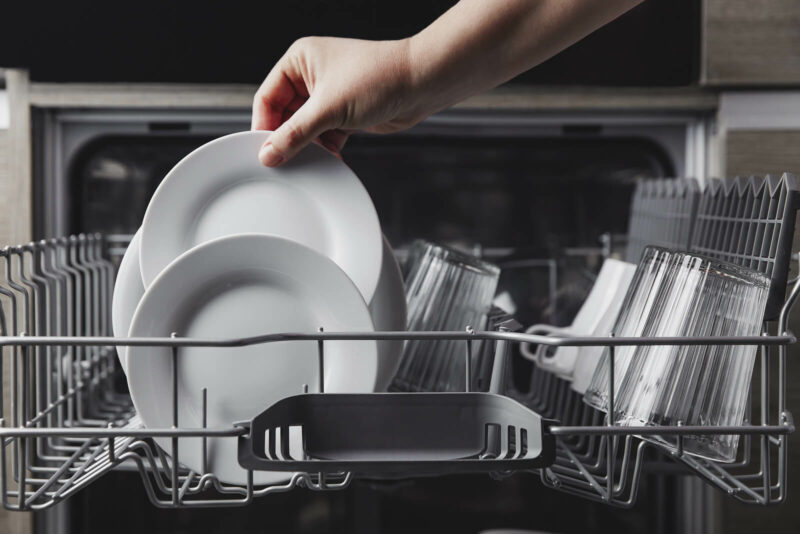Have you ever asked yourself, “How do dishwashers work?” Well, you’re far from alone. It seems that there are a lot of homeowners that are under the assumption that dishwashers use more water than they think. Let’s hammer out some of the misconceptions about dishwashers and set the record straight.
According to a 2015 study conducted by the U.S. Energy Information Administration’s (EIA), says 1 in 5 Americans that own dishwashers, don’t use their dishwashers! Yes, you heard that right. This is kind of a shocking statistic considering that it has been proven time and time again that washing dishes by hand uses more water than running your dishwasher. Understanding how dishwashers work is one way to better realize the benefits of using a dishwasher and how efficient they actually are.
How Do Dishwashers Work?
Behold the many wonders of the dishwasher! Dishwashers have come a long way since they first entered the scene in 1850. Invented by Joel Houghton, the first dishwasher was a wooden box that worked by splashing water on dirty dishes using a hand-cranked wheel. Clearly, a lot has changed throughout the years. Innovations in dishwasher technology have made them more efficient, affordable, and sanitary.
A dishwasher begins a full cycle by pumping cold water through a hose to fill its basin. Once the desired amount of water is pulled into the bottom of the unit, a heating coil located in the basin of the dishwasher starts to heat the water to temperatures as high as 130-140 Fahrenheit.
The dishwasher, then pulls the hot water into the sides and overhead of the unit by way of electric pumps to evenly distribute pressurized water from the nozzles above and on either side of your dishes. At the same time, detergent is being added to the water in the basin to deliver a mix of super hot and soapy water to the spray arms and nozzles.
Pressurized, scalding hot, soapy water is great when it comes to efficiently clean dishes, but that isn’t where the true magic happens. One of the biggest misconceptions about dishwashers is that they work by having to continually pull more fresh water into the unit during the course of a full dishwashing cycle.
Despite what people may think, the dirty water and runoff from the first cycle is recycled and reused multiple times during a full cycle. When the initial dishwashing cycle is complete, the water then flows back into the basin below where it is filtered, reheated, and sent back into the pressurized side nozzles and spray arms to again clean tough dirt and grime off of dishes in a sanitary fashion. Hence why dishwashers use less water and washing dishes by hand is inefficient when it comes to time, effort, and water consumption.
And since the water temperature inside your dishwasher reaches such scalding temps, it can efficiently sanitize your dishes while cleaning them, which works much better than murky, lukewarm sink water.
The Three Dishwasher Cycles
Now that you know how dishwashers work, it’s time to explain the different cycles of a dishwasher. Typically, there are three stages to a dishwasher cleaning cycle:
- Pre-wash or Rinse Cycle: The shortest dishwashing cycles, the first cycle is reserved for pre-wash and rinsing your dishes. This gets larger food particles off your dishes and gets them prepped for a longer, hotter, main wash cycle that follows. Some dishwasher models have a pre-wash detergent dispenser to add a little oomph to the overall wash cycle.
- Main Wash Cycle: Lasting anywhere from 20 minutes to a full hour, the main wash cycle can be tailored to suit the amount of dishes in your unit or to how dirty they are. During the main wash cycle, water will be heated, pumped through the unit, sprayed, collected again, then filtered a few times over as the cycle repeats to get dishes sparkling clean. When the heating coils turn off, the dish water will then drain, marking the end of the main wash cycle.
- Final Wash Cycle and Rinse: The final wash cycle does pull new, fresh water into the unit. The final rinse has the same function as the main wash, but typically doesn’t use detergent. It is meant to thoroughly rinse any remaining detergent or chemicals off of your dishes. In some units, after the water shuts off there is a drying cycle that uses the hot air left over from previous cycles to sanitize your dishes.
*One side note – Some dishwashers don’t come equipped with internal water heaters or a heat source built-in. They may pull from the existing water source that is connected to your home’s kitchen sink. It will use whatever water happens to be circulating at the time you start the cycle, so be sure to run your kitchen sink faucet on the hottest temperature setting so your dishes are receiving that flow of hot water.
Contact Wilshire Refrigeration For Cove Dishwasher Repair
Wilshire Refrigeration is factory certified to service technician Sub-Zero, Wolf, Cove Dishwasher, and other leading-brand appliances. Our team is trained in all the latest repair methods and equipment. For questions about Los Angeles appliance repair and to schedule repairs, call us today at 800-427-3653.




